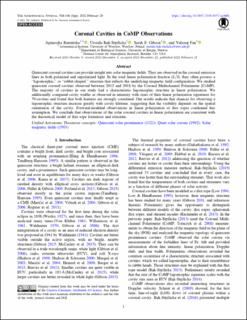| dc.contributor.author | Ruminska, Agnieszka | |
| dc.contributor.author | Bąk-Stȩślicka, Urszula | |
| dc.contributor.author | Gibson, Sarah E. | |
| dc.contributor.author | Fan, Yuhong | |
| dc.date.accessioned | 2022-12-15T08:05:06Z | |
| dc.date.available | 2022-12-15T08:05:06Z | |
| dc.date.created | 2022-05-30T15:37:08Z | |
| dc.date.issued | 2022 | |
| dc.identifier.issn | 0004-637X | |
| dc.identifier.uri | https://hdl.handle.net/11250/3037841 | |
| dc.description.abstract | Quiescent coronal cavities can provide insight into solar magnetic fields. They are observed in the coronal emission lines in both polarized and unpolarized light. In the total linear polarization fraction (L/I), they often possess a "lagomorphic," or "rabbit-shaped," structure that reflects the underlying magnetic field configuration. We studied quiescent coronal cavities observed between 2012 and 2018 by the Coronal Multichannel Polarimeter (CoMP). The majority of cavities in our study had a characteristic lagomorphic structure in linear polarization. We additionally compared cavity widths as observed in intensity with sizes of their linear polarization signatures for 70 cavities and found that both features are strongly correlated. Our results indicate that chances for observing a lagomorphic structure increase greatly with cavity lifetime, suggesting that the visibility depends on the spatial orientation of the cavity. Forward-modeled observations in linear polarization of flux ropes confirmed this assumption. We conclude that observations of the solar coronal cavities in linear polarization are consistent with the theoretical model of flux rope formation and structure. | en_US |
| dc.language.iso | eng | en_US |
| dc.publisher | IOP Publishing | en_US |
| dc.rights | Navngivelse 4.0 Internasjonal | * |
| dc.rights.uri | http://creativecommons.org/licenses/by/4.0/deed.no | * |
| dc.title | Coronal Cavities in CoMP Observations | en_US |
| dc.type | Journal article | en_US |
| dc.type | Peer reviewed | en_US |
| dc.description.version | publishedVersion | en_US |
| dc.rights.holder | Copyright 2022 the authors | en_US |
| dc.source.articlenumber | 146 | en_US |
| cristin.ispublished | true | |
| cristin.fulltext | original | |
| cristin.qualitycode | 2 | |
| dc.identifier.doi | 10.3847/1538-4357/ac469c | |
| dc.identifier.cristin | 2028193 | |
| dc.source.journal | The Astrophysical Journal (ApJ) | en_US |
| dc.identifier.citation | The Astrophysical Journal (ApJ). 2022, 926 (2), 146. | en_US |
| dc.source.volume | 926 | en_US |
| dc.source.issue | 2 | en_US |

